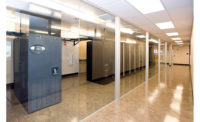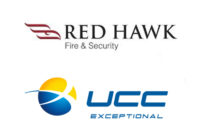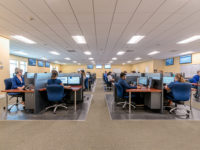Technology advances are having a major impact on third-party wholesale central stations. After playing a vital role in monitoring burglar and fire alarm signals for decades, the central stations increasingly are handling new types of signals, including monitoring the health and well-being of patients, children and the elderly; providing new mass communications options for campus environments, and more.
Increasingly today’s wholesale central stations also are integrating their systems with those of equipment manufacturers and third-party application providers, thereby giving dealers more options and powerful new capabilities that they can offer to their customers.
Healthcare Monitoring
“Telehealth and wearables are poised for explosive growth and are an excellent source of additional recurring monthly revenue,” predicts Christopher Baskin, CEO of American Two-Way, a wholesale central station located in Los Angeles.
Increasingly central stations are receiving signals from end users’ homes that come from blood pressure devices, glucose meters, devices measuring oxygen saturation and others. In a typical application, the central station would log this information, alerting a central station operator if, for example, a patient’s blood pressure was high for a certain number of days, at which point the central station might notify the patient or a family member.
Typically blood pressure or other healthcare devices use Bluetooth to transmit results to a gateway that sends the results to the central station using a cellular connection, explains Morgan Hertel, vice president of operations for Syracuse, N.Y.-based Rapid Response Monitoring. Dermal patches also may be used to collect patient data, notes Hertel — and Baskin notes that American Two-Way soon will monitor healthcare transmissions from the Apple Watch.
Insurance companies increasingly are finding that healthcare monitoring services merit reimbursement. “Insurance companies have found that if somebody comes out of complicated surgery, they often end up going back if complications develop and are not treated promptly — and that’s considerably more costly than monitoring, Hertel notes.
American Two-Way sometimes sells healthcare monitoring services in combination with another non-traditional service. The company offers a monthly subscription service that lets patients in their homes speak to a nurse who can answer medical questions, Baskin says.
Mobile Monitoring
Personal emergency response systems (PERS) designed to summon aid, sometimes worn as a pendant on a necklace, have long been a staple of residential alarm systems. Today PERS increasingly is becoming a mobile offering.
American Two-Way, for example, offers mobile PERS in the form of wristbands that a child or elderly adult can use to summon help. Central station operators have an audio connection with the device and can hear what is happening. In addition, the device uses cellular communications and has global positioning system (GPS) capability, enabling the central station to know where the person is located.
GPS also can be used to provide geo-fencing — a capability that can be used to generate an alert if, for example, a person with Alzheimer’s disease ventures outside a specific area. And through partnerships with product manufacturers, Rapid Response supports monitoring of crash detection sensors in vehicles and helmets.
Mobile monitoring can involve tracking assets as well as humans, Baskin notes. One of the more innovative options American Two-Way offers in this area is a dongle that connects to a vehicle’s on-board diagnostic (OBD) port and provides mobile assistance capability similar to services such as OnStar. Vehicles built since 1996 are required by law to have OBD ports, Baskin explains.
Mass Communications
Another new service offered by some wholesale central stations is to provide mass communications capability for schools, hospitals, office buildings or for a campus environment. Des Plaines, Ill.-based wholesale central station Emergency 24 Inc. offers a service that provides two-way communications through email and text messaging that can be used for emergency or more routine purposes. In the event of a shooter on a campus, for example, the service could be used to alert students and staff via their cellphones. The offering also gives students and staff the ability to send information to the central station.
“If a teacher sees the shooter running toward the gym, they can relay that information to the platform,” explains Kevin McCarthy, Emergency 24 national sales manager. The teacher could send a text message, video or photos from his or her phone to the central station, which could relay it to emergency personnel.
An authorized person at the school or other location uses a secure portal to control the service, McCarthy explains. “We encourage people to use it for non-emergency use,” he says, adding that the service can be used for communications that need to go to specific groups such as third-grade parents.
Rapid Response has integrated with a partner that provides a similar offering that lets students and staff download an app designed to enable them to report a wide range of incidents. As Hertel explains, a teacher might use the app to report bullying or an illegal drug sale.
Integration
Integrating central station automation software with other systems is another important trend for wholesale central stations.
Union, N.J.-based Affiliated Monitoring has now integrated its monitoring platform with more than 20 different digital video recorders (DVR), network video recorders (NVR) and IP camera manufacturers, enabling signals from video devices manufactured by those companies to be handled on a single platform, explains Michael Zydor, managing director for Affiliated Monitoring.
This benefits dealers because Affiliated can support a wide range of equipment, increasing the likelihood that dealers will be able to offer video verification with their preferred brands.
San Antonio, Texas-based wholesale central station United Central Control Inc. has been integrating its central station automation software with dealers’ customer relationship management (CRM) software.
“Dealers are getting more automated in their processes,” comments Mike Lamb, vice president and project director for United Central Control. “We help them by integrating their CRM system with our automation system.”
Doing so enables dealer personnel to use a single data entry point to populate both systems, Lamb explains. “In the past they would enter an account in the billing system and sales lead system and then have to do a swivel chair and enter the same information into our system,” he adds.
Considering all the new services they are offering, today’s wholesale central stations appear well positioned to see strong revenues moving forward. Many of these are revenue opportunities for their dealer bases as well. And tighter integration with dealer systems should help dealer profit margins, while also helping to cement dealer loyalty.





